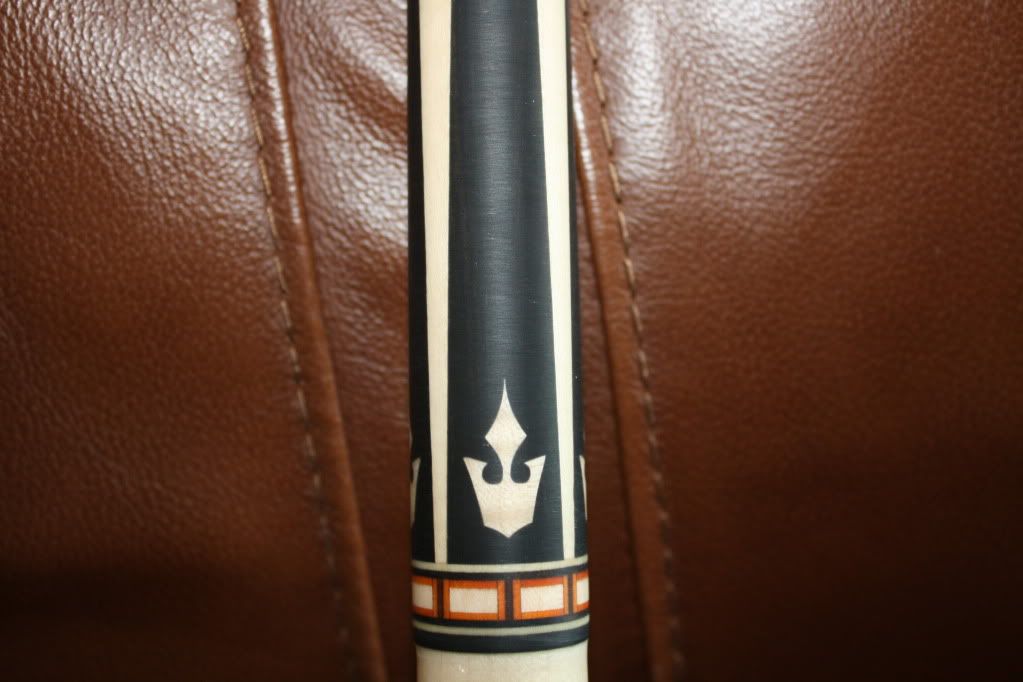Just to share some info ....
My procedure goes like this.... finish cut at joint is 840. Put on 3 coats of G5 and sand the next day with 220. Put on 5 coats of clear water born finish and sand the next day with 220. Put on 5 coats of water born finish and in 1 week, sand/wet sand/buff/polish.
I have read on the forum about General finishes and Target finishes so I tried them both.
General finish Clear Poly is a professional finish and is only available in gallons but with the proper amount of whining, they sent me a qt sample. The other finish is Target 9000 clear and is available in qts. Neither are exceptionally expensive.
The target finish is self crosslinking but I didn't perceive any great hardness. I tried the General finish with and without the crosslinker and didn't see much difference. Maybe it is just me or my methods. I am not saying that there is not a difference only that I didn't see it.
I use a 2 inch foam brush with the cue spinning slowly. I use a good foam brush with very fine foam. Put the finish on fast and as thick as you can. Spiral down the cue and then go back and touch the tip of the brush every 2 in to smooth the spirals. Do this only once and don't keep playing with it. Both finishes flowed out well.
The general finish builds much faster and dries quicker. 5 coats will build .010 easily and each coat dries in 10 to 15 min. The target won't build .010 in 5 coats and takes at least 30 minutes to dry between coats.
The general finish sands into fine dust. It does clog the paper more after 24 hours than after a week. The target finish always sands into little rolls or pills no matter how long you wait for it to harden and does not dust the same as general clear poly.
Both finishes polish out good and result in a water clear finish. The general finish clear poly does give a blue haze over dark wood like purple heart but I found that it dissipates after about a month. The target finish always is crystal clear.
I am going to stick with the General finish clear poly.
Kim
JUST A NOTE......... I NO LONGER USE THIS FINISH OR THIS PROCEDURE....... IT TAKES TOO LONG TO DRY AND IT TURNS YELLOW WITH TIME.............. I SEAL COAT WITH MAX 1618 EPOXY AND FINISH WITH SOLAREZ UV FINISH
My procedure goes like this.... finish cut at joint is 840. Put on 3 coats of G5 and sand the next day with 220. Put on 5 coats of clear water born finish and sand the next day with 220. Put on 5 coats of water born finish and in 1 week, sand/wet sand/buff/polish.
I have read on the forum about General finishes and Target finishes so I tried them both.
General finish Clear Poly is a professional finish and is only available in gallons but with the proper amount of whining, they sent me a qt sample. The other finish is Target 9000 clear and is available in qts. Neither are exceptionally expensive.
The target finish is self crosslinking but I didn't perceive any great hardness. I tried the General finish with and without the crosslinker and didn't see much difference. Maybe it is just me or my methods. I am not saying that there is not a difference only that I didn't see it.
I use a 2 inch foam brush with the cue spinning slowly. I use a good foam brush with very fine foam. Put the finish on fast and as thick as you can. Spiral down the cue and then go back and touch the tip of the brush every 2 in to smooth the spirals. Do this only once and don't keep playing with it. Both finishes flowed out well.
The general finish builds much faster and dries quicker. 5 coats will build .010 easily and each coat dries in 10 to 15 min. The target won't build .010 in 5 coats and takes at least 30 minutes to dry between coats.
The general finish sands into fine dust. It does clog the paper more after 24 hours than after a week. The target finish always sands into little rolls or pills no matter how long you wait for it to harden and does not dust the same as general clear poly.
Both finishes polish out good and result in a water clear finish. The general finish clear poly does give a blue haze over dark wood like purple heart but I found that it dissipates after about a month. The target finish always is crystal clear.
I am going to stick with the General finish clear poly.
Kim
JUST A NOTE......... I NO LONGER USE THIS FINISH OR THIS PROCEDURE....... IT TAKES TOO LONG TO DRY AND IT TURNS YELLOW WITH TIME.............. I SEAL COAT WITH MAX 1618 EPOXY AND FINISH WITH SOLAREZ UV FINISH
Last edited:

